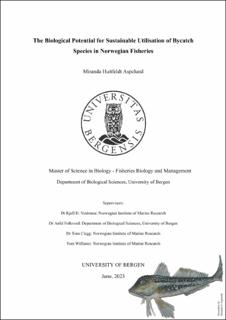The Biological Potential for Sustainable Utilisation of Bycatch Species in Norwegian Fisheries
Master thesis

View/
Date
2023-06-02Metadata
Show full item recordCollections
- Master theses [267]
Abstract
With a growing global population and an increasing demand for food in the future, novel marine resources are needed. Some bycatch species may have little or no commercial value when there is not an established market for the particular species and no fishery targets them directly. As a result of this, bycatch are in many instances discarded at sea and not reported. Discarding of catches is considered unsustainable and a waste of natural resources as the organisms are not utilised. The four bycatch species grey gurnard (Eutrigla gurnardus), long rough dab (Hippoglossoides platessoides), megrim (Lepidorhombus whiffiagonis) and Norway redfish (Sebastes viviparus) were examined by investigating to what extent the four species were landed and utilised in Norwegian fisheries using data from the Norwegian Directorate of Fisheries. Further, the discarded and unreported catches of the species in a coastal gillnet fishery and in offshore trawl and longline fisheries were explored using data from the Norwegian Reference Fleet. The current study found that relatively small quantities were landed of the four focus species in Norway, and that much greater quantities of the catches were discarded and not reported. On average for the four focus species, 99.6% of the total annual catch weight comprised of discarded and unreported catches in the three fisheries examined. The findings of this study indicate that there are possibilities for improved and increased utilisation of the four focus species. Considering the indices currently available for the abundance of the species, increased, sustainable utilisation of the species could be possible, as long as a precautionary approach is followed. Increased utilisation of bycatch species can provide a valuable source of food for human consumption while also reducing waste in the fisheries sector, and should therefore be considered an important resource and be better utilised in the future.